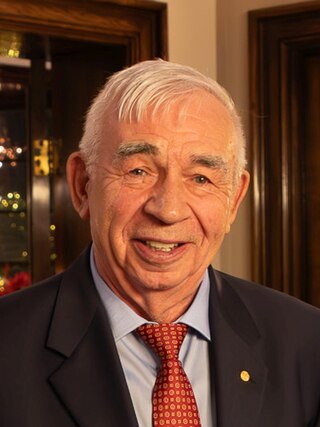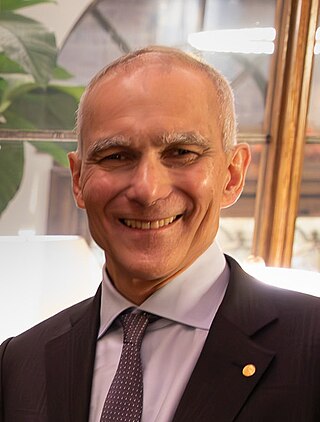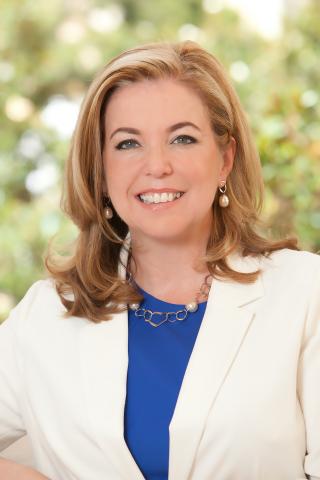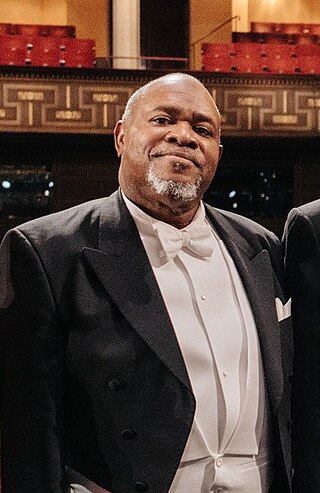Related Research Articles

Quantum dots (QDs) or semiconductor nanocrystals are semiconductor particles a few nanometres in size with optical and electronic properties that differ from those of larger particles via quantum mechanical effects. They are a central topic in nanotechnology and materials science. When a quantum dot is illuminated by UV light, an electron in the quantum dot can be excited to a state of higher energy. In the case of a semiconducting quantum dot, this process corresponds to the transition of an electron from the valence band to the conductance band. The excited electron can drop back into the valence band releasing its energy as light. This light emission (photoluminescence) is illustrated in the figure on the right. The color of that light depends on the energy difference between the conductance band and the valence band, or the transition between discrete energy states when the band structure is no longer well-defined in QDs.

Armand Paul Alivisatos is an American chemist and academic administrator who has served as the 14th president of the University of Chicago since September 2021. He is a pioneer in nanomaterials development and an authority on the fabrication of nanocrystals and their use in biomedical and renewable energy applications. He was ranked fifth among the world's top 100 chemists for the period 2000–2010 in the list released by Thomson Reuters.

Cadmium selenide is an inorganic compound with the formula CdSe. It is a black to red-black solid that is classified as a II-VI semiconductor of the n-type. It is a pigment, but applications are declining because of environmental concerns.

Nanochemistry is an emerging sub-discipline of the chemical and material sciences that deals with the development of new methods for creating nanoscale materials. The term "nanochemistry" was first used by Ozin in 1992 as 'the uses of chemical synthesis to reproducibly afford nanomaterials from the atom "up", contrary to the nanoengineering and nanophysics approach that operates from the bulk "down"'. Nanochemistry focuses on solid-state chemistry that emphasizes synthesis of building blocks that are dependent on size, surface, shape, and defect properties, rather than the actual production of matter. Atomic and molecular properties mainly deal with the degrees of freedom of atoms in the periodic table. However, nanochemistry introduced other degrees of freedom that controls material's behaviors by transformation into solutions. Nanoscale objects exhibit novel material properties, largely as a consequence of their finite small size. Several chemical modifications on nanometer-scaled structures approve size dependent effects.

A quantum dot solar cell (QDSC) is a solar cell design that uses quantum dots as the captivating photovoltaic material. It attempts to replace bulk materials such as silicon, copper indium gallium selenide (CIGS) or cadmium telluride (CdTe). Quantum dots have bandgaps that are adjustable across a wide range of energy levels by changing their size. In bulk materials, the bandgap is fixed by the choice of material(s). This property makes quantum dots attractive for multi-junction solar cells, where a variety of materials are used to improve efficiency by harvesting multiple portions of the solar spectrum.

Louis Edward Brus is an American chemist, and currently the Samuel Latham Mitchell Professor of Chemistry at Columbia University. He is the co-discoverer of the colloidal semi-conductor nanocrystals known as quantum dots. In 2023, he was awarded the Nobel Prize in Chemistry.

Alexey Ekimov or Aleksey Yekimov is a Russian solid state physicist and a pioneer in nanomaterials research. He discovered the semiconductor nanocrystals known as quantum dots in 1981, while working at the Vavilov State Optical Institute. In 2023, he was awarded the Nobel Prize in Chemistry for this discovery.

Taeghwan Hyeon is a South Korean chemist. He is SNU distinguished professor in the School of Chemical and Biological Engineering at Seoul National University, director of Center for Nanoparticle Research of Institute for Basic Science (IBS), and an associate editor of the Journal of the American Chemical Society.

Core–shell semiconducting nanocrystals (CSSNCs) are a class of materials which have properties intermediate between those of small, individual molecules and those of bulk, crystalline semiconductors. They are unique because of their easily modular properties, which are a result of their size. These nanocrystals are composed of a quantum dot semiconducting core material and a shell of a distinct semiconducting material. The core and the shell are typically composed of type II–VI, IV–VI, and III–V semiconductors, with configurations such as CdS/ZnS, CdSe/ZnS, CdSe/CdS, and InAs/CdSe Organically passivated quantum dots have low fluorescence quantum yield due to surface related trap states. CSSNCs address this problem because the shell increases quantum yield by passivating the surface trap states. In addition, the shell provides protection against environmental changes, photo-oxidative degradation, and provides another route for modularity. Precise control of the size, shape, and composition of both the core and the shell enable the emission wavelength to be tuned over a wider range of wavelengths than with either individual semiconductor. These materials have found applications in biological systems and optics.
A nanosheet is a two-dimensional nanostructure with thickness in a scale ranging from 1 to 100 nm.
Cherie R. Kagan is the Stephen J. Angello Professor of Electrical and Systems Engineering, Professor of Materials Science and Engineering, and Professor of Chemistry at the University of Pennsylvania. Kagan is an Associate Editor of ACS Nano and serves on the editorial boards of Nano Letters and NanoToday.

Moungi Bawendi is an American–Tunisian–French chemist. He is currently the Lester Wolfe Professor at the Massachusetts Institute of Technology. Bawendi is known for his advances in the chemical production of high-quality quantum dots. In 2023 he was awarded the Nobel Prize in Chemistry.

Vicki Leigh Colvin is a professor of engineering and molecular pharmacology at Brown University. She is the director of the Centre for Biomedical Engineering. Her work focuses on the synthesis and characterization of nanomaterials. She is a Fellow of the American Association for the Advancement of Science and the American Institute for Medical and Biological Engineering.

Sara E. Skrabalak is a James H. Rudy Professor at Indiana University. Skrabalak leads a research group in the department of chemistry which focuses on the development of new nanomaterials. She has an adjunct appointment in the department of intelligent systems engineering.
Sandra J. Rosenthal is the Jack and Pamela Egan Professor of Chemistry, professor of physics and astronomy, pharmacology, chemical and biomolecular engineering, and materials science at Vanderbilt University. She is a joint faculty member at Oak Ridge National Laboratory in the Materials Science and Technology Division and the director of the Vanderbilt Institute of Nanoscale Science and Engineering.

Perovskite nanocrystals are a class of semiconductor nanocrystals, which exhibit unique characteristics that separate them from traditional quantum dots. Perovskite nanocrystals have an ABX3 composition where A = cesium, methylammonium (MA), or formamidinium (FA); B = lead or tin; and X = chloride, bromide, or iodide.
Uri Banin is an Israeli nanotechnologist and physical chemist and a professor at the Hebrew University of Jerusalem, currently holding the Alfred & Erica Larisch Memorial Chair at the Institute of Chemistry. He is recognized as one of the pioneers of nanoscience in Israel.
Hedi Mattoussi is a Tunisian-American materials scientist and professor at Florida State University. His research considers colloidal inorganic nanocrystals for biological imaging and sensing. He is a Fellow of the American Physical Society, American Chemical Society and Materials Research Society.
Silicon quantum dots are metal-free biologically compatible quantum dots with photoluminescence emission maxima that are tunable through the visible to near-infrared spectral regions. These quantum dots have unique properties arising from their indirect band gap, including long-lived luminescent excited-states and large Stokes shifts. A variety of disproportionation, pyrolysis, and solution protocols have been used to prepare silicon quantum dots, however it is important to note that some solution-based protocols for preparing luminescent silicon quantum dots actually yield carbon quantum dots instead of the reported silicon. The unique properties of silicon quantum dots lend themselves to an array of potential applications: biological imaging, luminescent solar concentrators, light emitting diodes, sensors, and lithium-ion battery anodes.

William L. Wilson is a black American chemist. He serves as the Executive Director of the Center for Nanoscale Systems (CNS) at Harvard University. At Bell Labs, Wilson collaborated with 2023 Nobel Prize in Chemistry awardees, Louis Brus and Moungi Bawendi, in the early development and characterization of colloidal semi-conductor nanocrystals known as quantum dots. As an expert in holographic technologies, Wilson co-founded InPhase Technologies and served as their Chief Scientific Officer.
References
- ↑ "Jonathan Moreno and Christopher Murray Join the University of Pennsylvania as the Newest PIK Professors". Penn Today. 2006-10-27. Retrieved 2023-10-20.
- ↑ "Christopher B. Murray | Department of Chemistry". Department of Chemistry, University of Pennsylvania.
- 1 2 "Professor Christopher B. Murray". National Academy of Engineering.
- 1 2 "Chris Murray named MRS Fellow | Department of Chemistry". University of Pennsylvania. March 28, 2012.
- 1 2 "Clarivate Reveals 2020 Citation Laureates - Annual List of Researchers of Nobel Class". Clarivate. 23 September 2020.
- 1 2 3 Araghchini, Mohammad; Chen, Jun; Doan-Nguyen, Vicky; Harburg, Daniel V.; Jin, Donghyun; Kim, Jungkwun; Kim, Min Soo; Lim, Seungbum; Lu, Bin; Piedra, Daniel; Qiu, Jizheng; Ranson, John; Sun, Min; Yu, Xuehong; Yun, Hongseok (2013). "A Technology Overview of the PowerChip Development Program". IEEE Transactions on Power Electronics. 28 (9): 4182–4201. doi:10.1109/TPEL.2013.2237791. hdl: 1721.1/86982 . ISSN 0885-8993.
- 1 2 3 4 5 "Carnegie Mellon Materials Science and Engineering Seminar Series Christopher B. Murray" (PDF). Carnegie Mellon University. February 19, 2010.
- 1 2 3 "IBM's Chris Murray Joins Department of Chemistry | Department of Chemistry". Department of Chemistry, University of Pennsylvania. Oct 26, 2006.
- 1 2 3 Robinson, Julia (2023-10-11). "The quantum dot story". Chemistry World.
- ↑ Linke, Heiner (2023). Quantum dots – Seeds of Nanoscience. The Royal Swedish Academy of Sciences.
- 1 2 "Christopher B. Murray | Penn Arts & Sciences Endowed Professors". Department of Arts & Sciences, University of Pennsylvania.
- ↑ "Christopher B. Murray Inventions, Patents and Patent Applications - Justia Patents Search". patents.justia.com.
- ↑ "Past Recipients". American Chemical Society.
- ↑ "Archive Honorary Doctorates - Organisation - Utrecht University". Utrecht University.
- ↑ "Dies Natalis 2011, Utrecht University 375 anniversary - Organisation - Utrecht University". Utrecht University. Retrieved 13 October 2023.
- ↑ Flanagan, Dave (19 March 2012). "Materials Research Society Announces 2012 MRS Fellows". Advanced Science News.